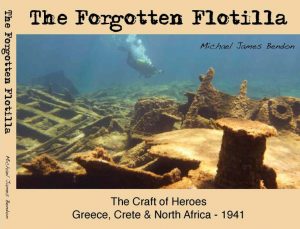- Author
- Book reviewer
- Subjects
- History - WW2, Book reviews, Naval Engagements, Operations and Capabilities
- Tags
-
- RAN Ships
- None noted.
- Publication
- June 2015 edition of the Naval Historical Review (all rights reserved)
The Forgotten Flotilla – The Craft of Heroes Greece, Crete & North Africa 1941 by Michael James Bendon. Published by Ligare Book Printers, Sydney, 2014. Landscape format hardcover of 198 pages, liberally illustrated with coloured photographs and diagrams, rrp $49.95.

Five years ago an Australian marine archaeologist investigating the ancient city of Phalascarna in western Crete contacted the NHS. Dr. Michael Bendon had discovered a submerged WW II vessel close in-shore thought to be linked to the 1941 Anzac evacuation of Crete and sought assistance identifying the vessel. From photographs provided this appeared to be the wreck of a landing craft but the Society was unable to offer much help other than suggesting Royal Naval authorities might have further information.
From these humble beginnings has emerged a fascinating story taking us through the development of landing craft and specifically Tank Landing Craft (TLC) which were vital to many Mediterranean and Pacific operations. The first batch of 20 Mk1 TLCs commenced construction by various British yards in mid 1940. For ease of transportation they were prefabricated in four sections which could be off-loaded without the need for huge cranes and then literally bolted together with minimum labour. By late 1940 these vessels and their crews were convoyed around Africa and 18 craft re-assembled at Port Said. With minimum work-up an inexperienced crew of 14 officers and men were putting their ungainly 160 ft (48.7 m) x 30 ft (9.1 m) craft into service. Although designed for tanks and other heavy supplies, in an emergency they could also lift 500 troops.
In April 1941 they were engaged in the evacuation of troops, mainly the Anzac Corps, from Greece. To avoid the attention of German bombers the evacuations were made at night from beachheads (most wharves had been destroyed) to larger ships waiting off-shore. With the majority of these troops relocated to Crete preparations were made for these poorly armed forces to defend the island. They only had to wait one month for the largest airborne invasion undertaken by German paratroops which eventually captured an airfield from which the end was inevitable. The resultant evacuation of Anzacs from Crete with minimum air cover took a heavy toll on men and naval forces. This was the end of a humble ship without name, TLC A6, commanded by SBLT John Sutton, DSO, RNVR. Making her way to help evacuate troops further south at Sphakia, she was overcome by three Luftwaffe JU87s and beached herself off Phalasarna, to be discovered 70 years later.
This well researched and interesting story provides a wonderful insight into the development of Tank Landing Craft and their early wartime operations and the development of amphibious warfare.
Reviewed by Arcturus




